Numerical Analysis of the Ultimate Bearing Capacity of Strip Footing Constructed on Sand-over-Clay Sediment
Abstract
1. Introduction
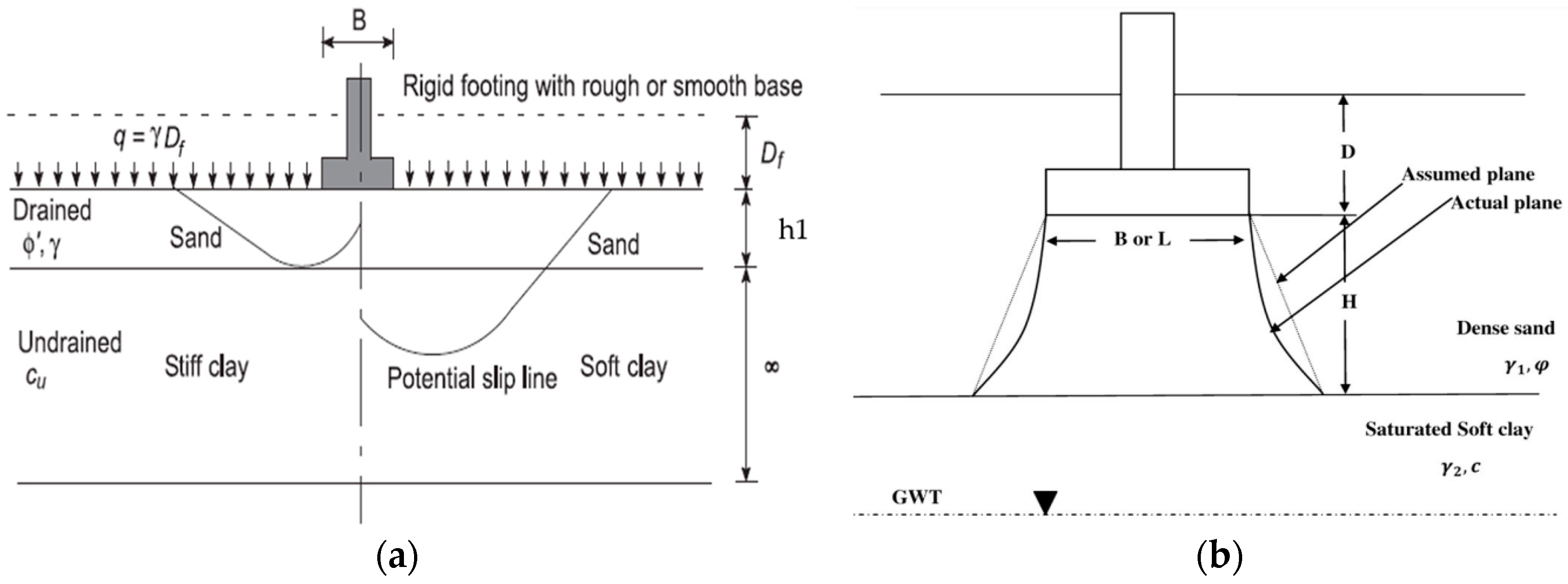
2. Research Methodology
3. Results and Discussion
3.1. Verification and Mesh Sensitivity Analysis of FE Model
3.2. Effect of Sandy Soil Layer Thickness on Bearing Capacity and Soil Settlement
3.2.1. Footing Behavior at Elastic Settlement of 350 mm
3.2.2. Footing Behavior at Elastic Settlement of 250 mm
3.3. Plastic Shear and Vertical Stress Distribution
3.4. Effect of Sandy Soil Unit Weight on Bearing Capacity and Soil Settlement
3.5. Effect of Modulus of Elasticity of Sandy Soil on Bearing Capacity
3.6. Effect of Cohesion on Bearing Capacity and Soil Settlement
4. Conclusions
- An increase in sandy soil layer thickness over footing width (h1/B) ratio and elastic settlement values resulted in an improvement of the ultimate bearing capacities. This could be attributed to the fact that soil becomes stronger with increased depth;
- Increasing the sandy soil layer thickness over footing width (h1/B) ratio from 0.15 to 2.0 increased the ultimate bearing capacities with elastic settlements of 350 mm and 250 mm by 145.62% and 101.66%, respectively;
- When sandy soil layer thickness (h1) becomes greater than or equal to the width of the footing (B), the bearing stress of the soil strengthens at a higher rate when compared to lower sandy soil layer thickness (h1) values;
- Higher top layer (sandy soil) thickness leads to larger shear stress distribution along its depth and converts the layered soil medium into a homogeneous soil case (as the majority of the shear stress lies in the top layer);
- At a settlement of 350 mm, bearing capacity increased by 6.91% and 5.28% for h1/B = 1.0 when the sandy soil’s unit weight was increased from 14 kN/m3 to 15 kN/m3 and 18 kN/m3, respectively. For h1/B = 2.0, the bearing capacity increased by 2.03% and 6.46%, with an increase in the sandy soil’s unit weight from 14 kN/m3 to 17 kN/m3 and 18 kN/m3, respectively;
- At h1/B > 1.0, higher ultimate bearing capacity occurs with an increase in the sandy soil’s unit weight and elastic modulus, while at h1/B ≤ 1.0, the ultimate bearing capacity increases till a threshold value of the sandy soil unit weight;
- At a settlement of 350 mm, an increase in the sandy soil modulus of elasticity from 10 MPa to 15 MPa and 18 MPa resulted in improving the bearing capacity by about 15.91% and 25.99%, respectively;
- At h1/B ≤ 1.0, higher ultimate bearing capacity occurs with an increase in the cohesive strength of clayey soil, while at h1/B > 1.0, the ultimate bearing capacity increases until a threshold value of cohesive strength of clay;
- An increase in clayey soil’s cohesive strength from 20 kPa to 30 kPa increased the soil bearing capacity for h1/B = 0.15 (settlement of 300 mm) and h1/B = 2.0 (settlement of 350 mm) by 24.31% and 3.47%, respectively;
- Bearing capacity was significantly improved with an increased modulus of the elasticity of sand. In addition, for lower clay layer thickness, the positive effect of cohesive strength on the bearing capacity was observed.
Author Contributions
Funding
Data Availability Statement
Conflicts of Interest
References
- Haghbin, M. Bearing Capacity of Strip Footings Resting on Granular Soil Overlying Soft Clay. Int. J. Civil Eng. 2016, 14, 467–477. [Google Scholar] [CrossRef]
- Shiau, J.S.; Lyamin, A.V.; Sloan, S.W. Bearing capacity of a sand layer on clay by finite element limit analysis. Can. Geotech. J. 2003, 4, 900–915. [Google Scholar] [CrossRef]
- Mosadegh, A.; Nikraz, H. Bearing Capacity Evaluation of Footing on a Layered-Soil Using ABAQUS. J. Earth Sci. Clim. Chang. 2015, 6, 264. [Google Scholar]
- Quang, P.N.; Ohtsuka, S. Ultimate Bearing Capacity of Rigid Footing on Two-Layered Soils of Sand-Clay. Int. J. Geomech. 2021, 21, 04021115. [Google Scholar]
- Terzaghi, K.; Peak, R.B. Soil Mechanics in Engineering Practice; John Wiley: New York, NY, USA, 1948. [Google Scholar]
- Zheng, G.; Zhao, J.; Zhou, H.; Zhang, T. Ultimate Bearing Capacity of Strip Footings on Sand Overlying Clay under Inclined Loading. Comput. Geotech. 2019, 106, 266–273. [Google Scholar] [CrossRef]
- Panwar, V.; Dutta, R.K. Numerical Study of Ultimate Bearing Capacity of Rectangular Footing on Layered Sand. J. Achiev. Mater. Manuf. Eng. 2020, 101, 15–26. [Google Scholar] [CrossRef]
- Panwar, V.; Dutta, R.K. Development of Bearing Capacity Equation for Rectangular Footing under Inclined Loading on Layered Sand. Civ. Eng. Infrastruct. J. 2021, 56, 173–192. [Google Scholar]
- Afaq, A.; Aiman, A.; Usman, A.; Mohamed, E.; Farid, A. Prediction of columns with GFRP bars through Artificial Neural Network and ABAQUS. Structures 2022, 40, 247–255. [Google Scholar]
- Muhammad, K.; Farid, A. Nonlinear FE analysis of fiber reinforced cementitious matrix strengthened RC columns. In Computational Modelling of Concrete and Concrete Structures; CRC Press: Boca Raton, FL, USA, 2022; pp. 219–225. [Google Scholar]
- Khalil, A.; Elkafrawy, M.; Hawileh, R.; AlHamaydeh, M.; Abuzaid, W. Numerical Investigation of Flexural Behavior of Reinforced Concrete (RC) T-Beams Strengthened with Pre-Stressed Iron-Based (FeMnSiCrNi) Shape Memory Alloy Bars. J. Compos. Sci. 2023, 7, 258. [Google Scholar] [CrossRef]
- Elkafrawy, M.; Khalil, A.; AlHamaydeh, M.; Hawileh, R.; Abuzaid, W. Enhancing the Shear Capacity of RC Beams with Web Openings in Shear Zones Using Pre-Stressed Fe-SMA Bars: Numerical Study. Buildings 2023, 13, 1505. [Google Scholar] [CrossRef]
- Reza, Z.M.; Vahid, R.; Ehsan, I. Evaluation on Bearing Capacity of Ring Foundations on two-Layered Soil. World Acad. Sci. Eng. Technol. 2012, 61, 1108–1112. [Google Scholar]
- Farid, A.; Chahmi, O.; Yousef, A.; Haya, H.M.; Hakem, A. FE modeling of concrete beams and columns reinforced with FRP composites. Def. Technol. 2021, 17, 1–14. [Google Scholar]
- Selim, A.H.; Fardin, M.; Jamal, A.A.; Rami, A.H.; Farid, A.; Muhammad, K. Finite Element Modeling of Engineered Cementitious Composite (ECC) Prisms and Beams. In Proceedings of the Advances in Science and Engineering Technology International Conferences, ASET, Dubai, United Arab Emirates, 21–24 February 2022. [Google Scholar]
- Rao, P.; Liu, Y.; Cui, J. Bearing capacity of strip footings on two-layered clay under combined loading. Comput. Geotech. 2015, 69, 210–218. [Google Scholar] [CrossRef]
- Gang, Z.; Jiapeng, Z.; Haizuo, Z. Ultimate bearing capacity of two interfering strip footings on sand overlying clay. Acta Geotech. 2021, 16, 2301–2311. [Google Scholar]
- Qiyi, Z.; Shaoxuan, W.; Liangpeng, W.; Zhijie, L. Theoretical Analysis of Bearing Capacity of Shallowly Embeded Rectangular Footing of Marine Structures. J. Ocean. Univ. China 2019, 18, 123–132. [Google Scholar]
- Ali, R.; Amin, K.; Arsalan, G. Static and Seismic Bearing Capacity of Strip Footings on Sand Overlying Clay Soils. Iran. J. Sci. Technol. Trans. Civ. Eng. 2018, 43, 69–80. [Google Scholar]
- Das, P.P.; Khatri, V.N.; Doley, R.; Dutta, R.K.; Yadav, J.S. Estimation of bearing capacity of shallow footings on layered sand using finite elements analysis. J. Eng. Des. Technol. 2022, 22, 385–403. [Google Scholar] [CrossRef]
- Rakesh, K.D.; Vishwas, N.K.; Nitesh, K. Ultimate Bearing Capacity of Strip Footing on Sand Underlain By Clay under Inclined Load. Civ. Environ. Eng. Rep. 2022, 32, 116–137. [Google Scholar]
- Azam, G.; Wang, M.C. Bearing Capacity of Strip Footing Supported by Two-Layer c-phi Soils. Transp. Res. Rec. 1991, 1331, 56–66. [Google Scholar]
- Samira, E.K. Numerical Modeling of Foundations on Dense Sand Overlaying Loose Sand. Ph.D. Thesis, Concordia University, Montreal, QC, Canada, 2016. [Google Scholar]
- Sujit, K.D.; Mukul, C.B. Improved performance of soft clay foundations using stone columns and geocell-sand mattress. Geotext. Geomembr. 2013, 41, 26–35. [Google Scholar]
- Mahmoud, G.; Javad, N.A. Bearing capacity of geosynthetic encased stone columns. Geotext. Geomembr. 2013, 38, 26–36. [Google Scholar]
- Castro, J. Numerical modelling of stone columns beneath a rigid footing. Comput. Geotech. 2014, 60, 77–87. [Google Scholar] [CrossRef]
- Arushi, G.; Rakesh, K.D.; Rajnish, S.; Vishwas, N.K. Ultimate Bearing Capacity of Square/Rectangular Footing on Layered Soil. Indian Geotech. J. 2017, 47, 303–313. [Google Scholar]
- Panwar, V.; Dutta, R.K. Bearing capacity of rectangular footing on layered sand under inclined loading. J. Achiev. Mater. Manuf. Eng. 2021, 108, 49–62. [Google Scholar] [CrossRef]
- Gütz, P.; Peralta, P.; Abdel-Rahman, K.; Achmus, M. Numerical Investigation of Spudcan Footing Penetration in Layered Soil. In Computational Methods in Marine Engineering V—Proceedings of the 5th International Conference on Computational Methods in Marine Engineering, Hamburg, Germany, 29–31 May 2013; CIMNE: Barcelona, Spain, 2013. [Google Scholar]
- Lee, K.K.; Cassidy, M.J.; Randolph, M.F. Bearing capacity on sand overlying clay soils: Experimental and finite-element investigation of potential punch-through failure. Géotechnique 2013, 63, 1271–1284. [Google Scholar] [CrossRef]
- Jyant, K.; Manash, C. Soils and Foundations. Bearing capacity of a circular foundation on layered sand–clay media. Indian Geotech. J. 2015, 55, 1058–1068. [Google Scholar]
- Insaf, S.; Sadok, B.; Belounar, L. Bearing Capacity of Ring Footing on Two Layers Soil by Numerical Approach. In Proceedings of the 13th Arab Structural Engineering Conference, Blida, Algeria, 13–15 December 2015. [Google Scholar]
- Hamed, G.; Ehsan, S.H. Bearing Capacity Factors of Ring Footings by Using the Method of Characteristics. Geotech. Geol. Eng. 2017, 35, 2137–2146. [Google Scholar]
- Omid, S.; Hosseininia, E.S. Bearing capacity of ring footings on cohesionless soil under eccentric load. Comput. Geotech. 2017, 92, 169–178. [Google Scholar]
- Sharma, V.; Kumar, A. Strength and Bearing Capacity of Ring Footings Resting on Fibre-Reinforced Sand. Int. J. Geosynth. Ground Eng. 2017, 3, 9. [Google Scholar] [CrossRef]
- Jitesh, T.C.; Dodagoudar, G.R. Finite Element Evaluation of Vertical Bearing Capacity Factors Nc′, Nq′ and Nγ′ for Ring Footings. Geotech. Geol. Eng. 2018, 37, 741–754. [Google Scholar]
- Yang, C.; Zhu, Z.; Xiao, Y. Bearing Capacity of Ring Foundations on Sand Overlying Clay. Appl. Sci. 2020, 10, 4675. [Google Scholar] [CrossRef]
- Surya, D.P.; Manash, C. Behavior of Ring Footing on Two-Layered Soil due to Various Loading Positions. Int. J. Geomech. 2022, 22, 04022049. [Google Scholar]
- Vesic, A.S. Analysis of Ultimate Loads of Shallow Foundations. J. Soil Mech. Found. Div. 1973, 99, 45–73. [Google Scholar] [CrossRef]
- Burd, H.J.; Frydman, S. Bearing capacity of plane-strain footings on layered soils. Can. Geotech. J. 1997, 34, 241–253. [Google Scholar] [CrossRef]


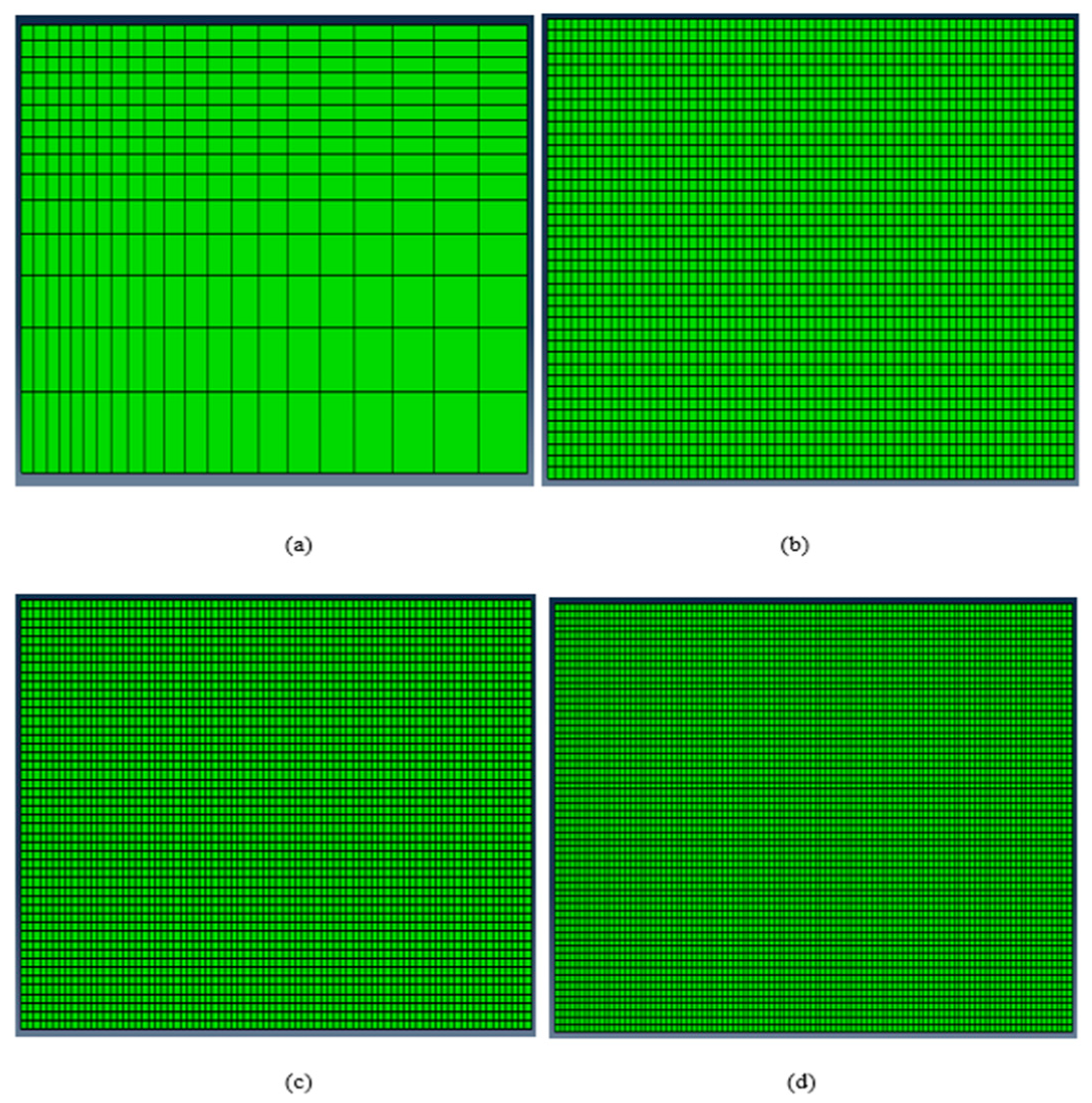
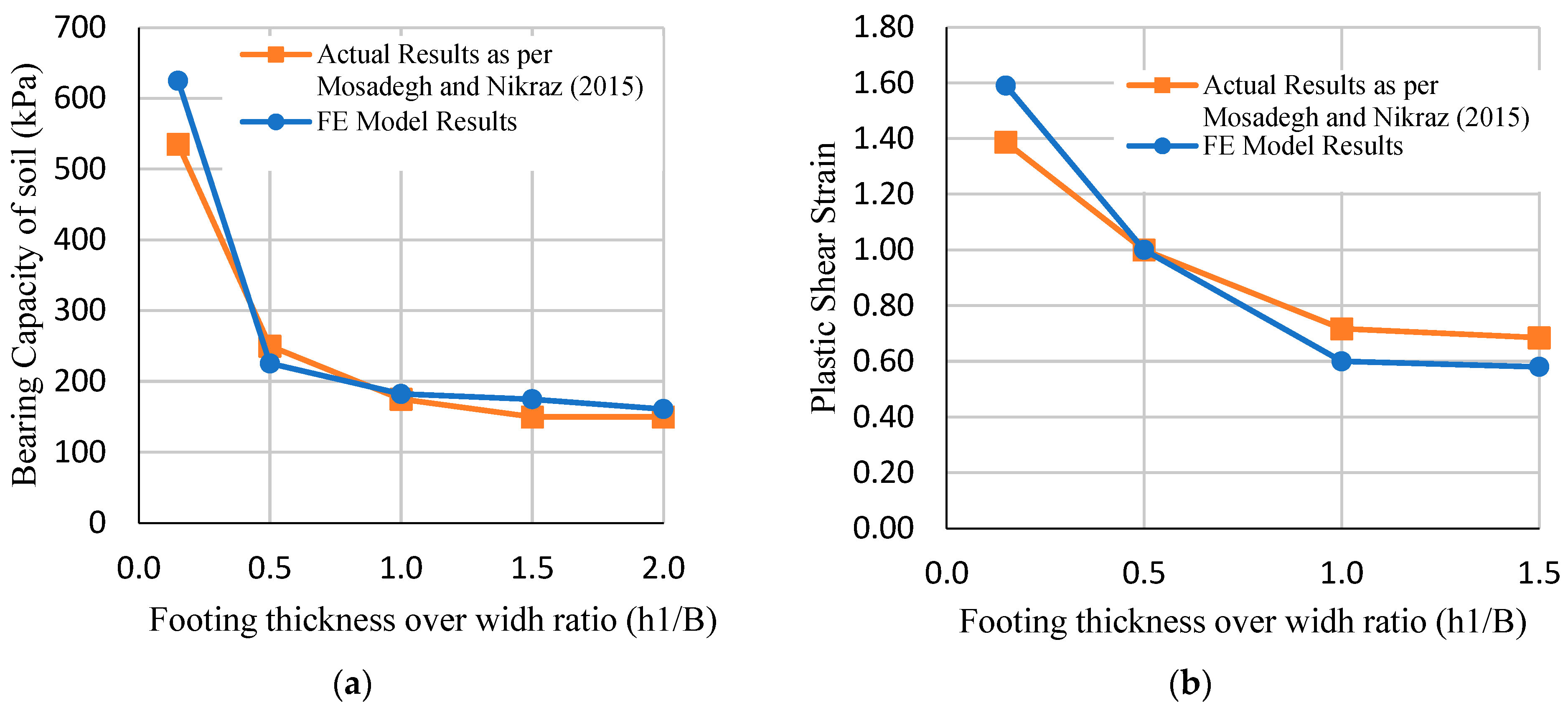

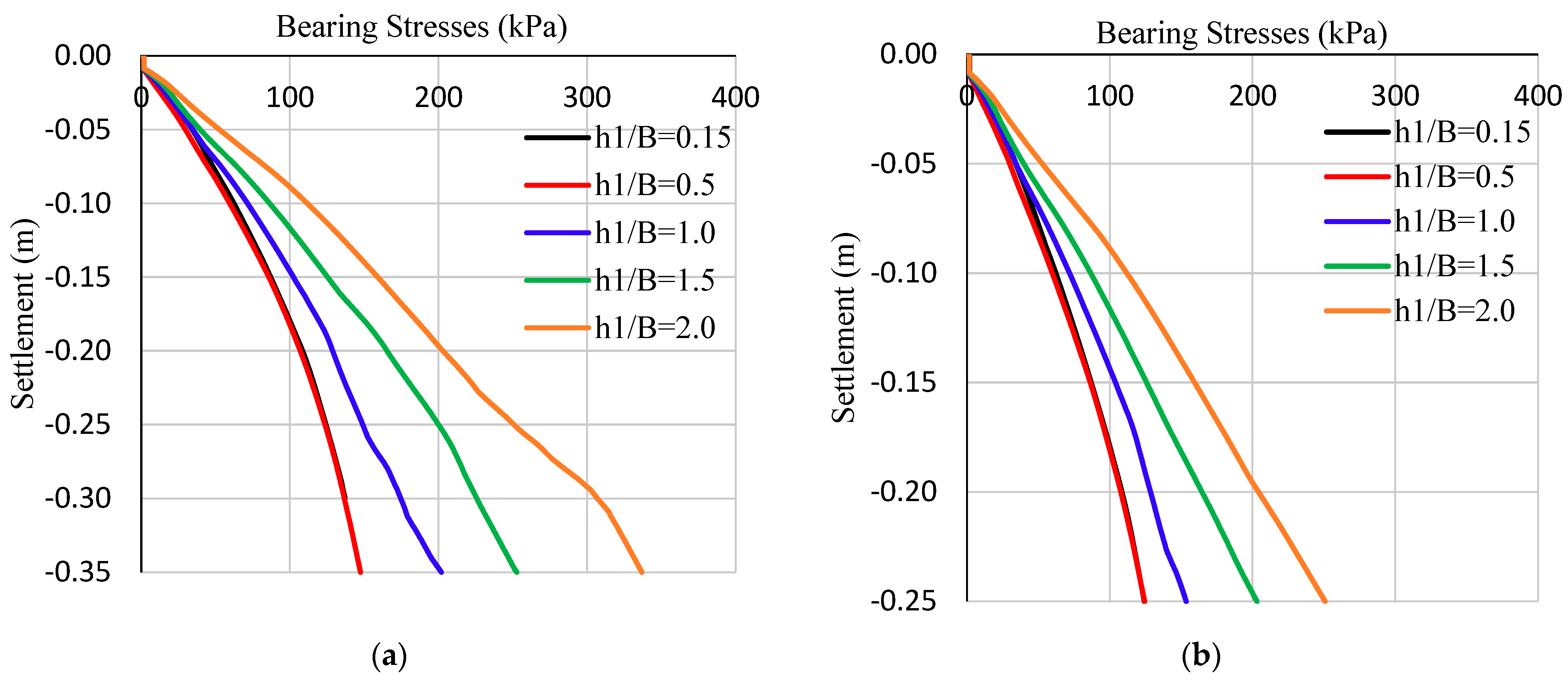


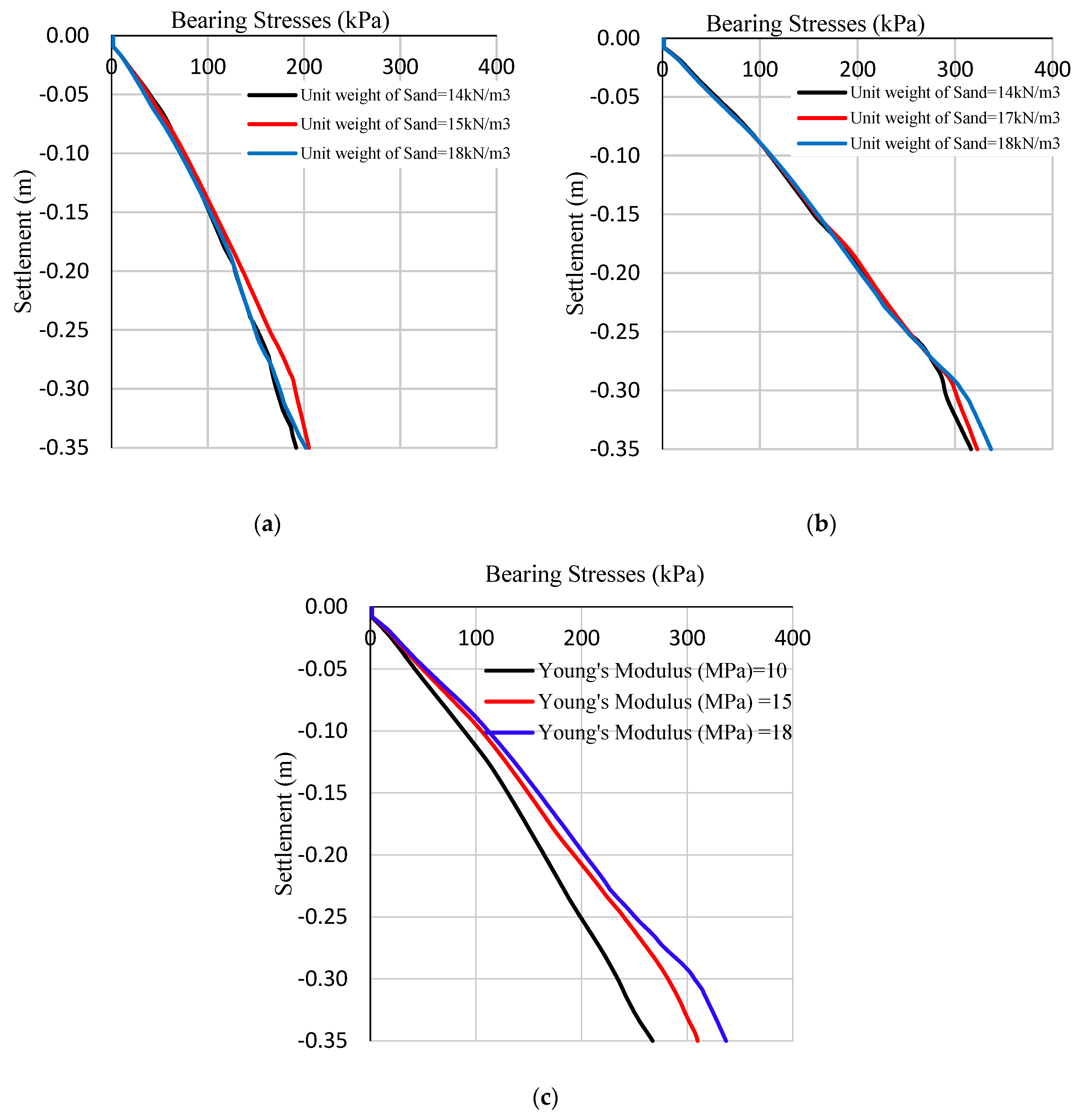

| No. | Material Properties | ||
|---|---|---|---|
| Soil Type | Parameter | Value | |
| 1 | Sandy Soil | Unit Weight, γ′ (kN/m3) | 18 |
| Modulus of Elasticity, E′ (MPa) | 18 | ||
| Cohesive Strength, d′ (kPa) | 0.9 | ||
| Poisson’s Ratio | 0.3 | ||
| Effective internal friction angle, ϕ′(deg) | 45° | ||
| Flow stress ratio, K | 1 | ||
| Dilation angle | 4° | ||
| 2 | Clayey Soil | Unit Weight, γ′ (kN/m3) | 15 |
| Modulus of Elasticity, E′ (MPa) | 6 | ||
| Cohesive Strength (kPa) | 25 | ||
| Poisson’s Ratio | 0.3 | ||
| Effective internal friction angle (deg) | 5° | ||
| Dilation angle | 1° | ||
| Model | Mesh Size (m) | Ultimate Layered Soil Bearing Capacity (kPa) | Plastic Shear Strain | Run Time (Seconds) |
|---|---|---|---|---|
| 1 | 0.45 to 2 | 228 | 0.75 | 20 |
| 2 | 0.25 | 230 | 1.00 | 55 |
| 3 | 0.2 | 240 | 0.89 | 80 |
| 4 | 0.15 | 227 | 1.14 | 156 |
| Results from [3] | 250 | 0.90 | - | |
| Model | Mesh (m) | Ultimate Layered Soil Bearing Capacity (kPa) | Plastic Shear Strain | Run Time (Seconds) |
|---|---|---|---|---|
| 1 | 0.45 to 2 | 201 | 0.34 | 42 |
| 2 | 0.30 | 193 | 0.46 | 100 |
| 3 | 0.25 | 195 | 0.53 | 248 |
| 4 | 0.20 | 202 | 0.59 | 337 |
| Ultimate Bearing Capacity of Layered Soil (kPa) | ||||||
|---|---|---|---|---|---|---|
| h1/B | 0.15 | 0.5 | 1.0 | 1.5 | 2.0 | |
| Elastic Displacement | 350 mm | 137.14 | 147.45 | 201.91 | 252.74 | 336.84 |
| 250 mm | 124.22 | 124.35 | 153.52 | 203.02 | 250.50 | |
| Sandy Soil Unit Weight | 14 kN/m3 | - | - | 191.78 | - | 316.40 |
| 15 kN/m3 | - | - | 205.03 | - | - | |
| 17 kN/m3 | - | - | - | - | 322.83 | |
| 18 kN/m3 | - | - | 201.91 | - | 336.84 | |
| Elastic Modulus of Sandy Soil | 10 MPa | - | - | - | - | 267.36 |
| 15 MPa | - | - | - | - | 309.89 | |
| 18 MPa | - | - | - | - | 336.84 | |
| Clayey Soil Cohesion | 20 kPa | 122.71 * | - | - | - | 322.79 |
| 25 kPa | 137.14 * | - | - | - | 336.84 | |
| 30 kPa | 152.54 * | - | - | - | 334.00 | |
Disclaimer/Publisher’s Note: The statements, opinions and data contained in all publications are solely those of the individual author(s) and contributor(s) and not of MDPI and/or the editor(s). MDPI and/or the editor(s) disclaim responsibility for any injury to people or property resulting from any ideas, methods, instructions or products referred to in the content. |
© 2024 by the authors. Licensee MDPI, Basel, Switzerland. This article is an open access article distributed under the terms and conditions of the Creative Commons Attribution (CC BY) license (https://creativecommons.org/licenses/by/4.0/).
Share and Cite
Banu, S.; Attom, M.; Abed, F.; Vandanapu, R.; Astillo, P.V.; Al-Lozi, N.; Khalil, A. Numerical Analysis of the Ultimate Bearing Capacity of Strip Footing Constructed on Sand-over-Clay Sediment. Buildings 2024, 14, 1164. https://doi.org/10.3390/buildings14041164
Banu S, Attom M, Abed F, Vandanapu R, Astillo PV, Al-Lozi N, Khalil A. Numerical Analysis of the Ultimate Bearing Capacity of Strip Footing Constructed on Sand-over-Clay Sediment. Buildings. 2024; 14(4):1164. https://doi.org/10.3390/buildings14041164
Chicago/Turabian StyleBanu, Shaziya, Mousa Attom, Farid Abed, Ramesh Vandanapu, Philip Virgil Astillo, Naser Al-Lozi, and Ahmed Khalil. 2024. "Numerical Analysis of the Ultimate Bearing Capacity of Strip Footing Constructed on Sand-over-Clay Sediment" Buildings 14, no. 4: 1164. https://doi.org/10.3390/buildings14041164
APA StyleBanu, S., Attom, M., Abed, F., Vandanapu, R., Astillo, P. V., Al-Lozi, N., & Khalil, A. (2024). Numerical Analysis of the Ultimate Bearing Capacity of Strip Footing Constructed on Sand-over-Clay Sediment. Buildings, 14(4), 1164. https://doi.org/10.3390/buildings14041164








